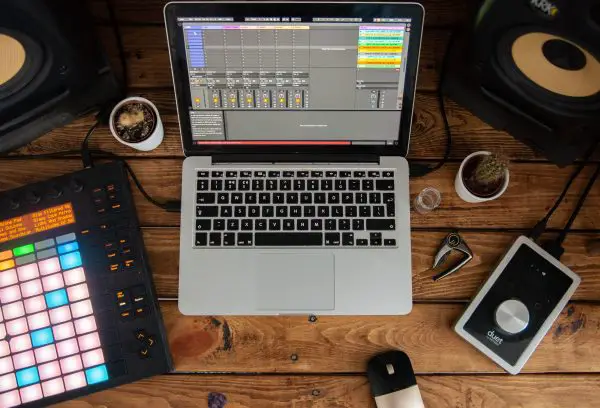
This will mainly be mixed by the sound engineer so you can hear yourself and the other members of the band! The last bit is to get a monitor line from the sound desk and put it into channel 1 on the mixer. This allows the drummer to mix click and track independently. The link from the DI goes back into the mixer (channel 4/5). This is the important bit that stops crosstalk or click-bleed coming through the PA! Since it’s passing through the DI box *, the desk is getting a clean and balanced signal. The right channel goes onto the sound desk. The left channel goes into the mixer (channel 2/3) and right channel goes into the input on your DI box. (I use stereo headphone extenders to deal with cable length issues live *). The phone is playing stereo sound with the splitter cable * separating the track: click in the left channel and track in the right channel. I’ll number bits of gear from earlier in the post for reference. Here’s how you want to set up all your equipment: Putting it together: Running backing tracks live I usually recommend having the backing t Rack on the Right channel and c Lick on the Left as it’s easier to remember if you ever need to. Click (in sync with the backing track and with a count-in for the drummer!).
#Backing tracks program for mac full
I’ll do a full write up about this in another post but we basically want a stereo track: To use this setup we need to create the backing track in a specific way.

Although that’s usually more than enough for most people starting out. Note: Doing it this way only lets you run MONO tracks. Personal mix: The drummer can tweak the backing track, click, master and monitor volumes to create the best mix for them.Foolproof: I’ve never had it fail on me in 50+ shows.Portable: My entire setup fits within this Stagg Pedalboard*.Cheap: All of the actual backing track gear can be picked for £75 or less.I’m going to show you my way of implementing the split-mono method of backing tracks. The simplest backing track setup for drummers: If you tend to play more laid back styles of music or have the luxury of having enough members on stage to play all the additional sounds, then lucky you! You’ll probably be fine without a backing track. alt-rock, metal, pop) which makes use of a lot of different tracks to add depth and thickness to your songs, you’ll want to play to a backing track live to make it sound like the record for your fans. Should you consider using a backing track?Įver since The Beatles popularised multi-track recording, musicians have slowly been adding more and more layers to their recorded songs. Let’s consider if you need a backing track. and why I think it’s the best way to play backing tracks live for people starting out.my exact setup to get both backing and click tracks for drummers.

We receive so many compliments about our live sound because we use backing tracks live. I’m sure you’ll agree with me when I say that as a band, recreating your recorded sound live is crucial.


 0 kommentar(er)
0 kommentar(er)
